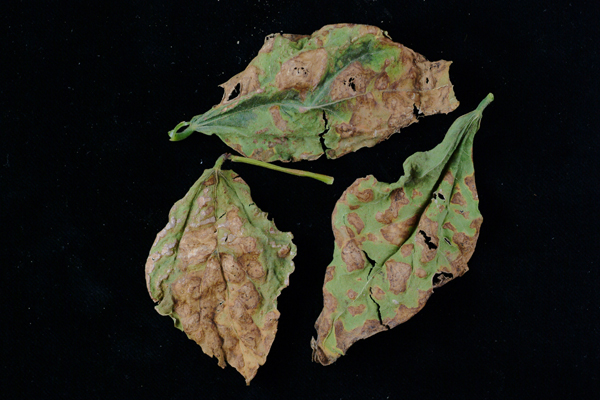Bean blight
Xanthomonas axonopodis pv. phaseoli
Profile
Bean bacterial blight is caused by the bacterium Xanthomonas axonopodis pv. phaseoli . Spots appear on leaves that look like they have been burned, which is how this disease got the name bean blight. Xanthomonas axonopodis pv. phaseoli is listed as a Union regulated non-quarantine pest.
Damage symptoms


Preferably on the older leaves , small, light green spots appear at first, which quickly increase in size to up to two centimeters in warm, humid weather. These spots eventually turn brown. They are surrounded by no or only a very narrow, light-colored yard. If several spots flow together and the leaf does not die in the process, it looks like it has been burned.
Reddish longitudinal stripes form on the stems , and ring-shaped infestations are often found at the stem nodes. There the stem then usually kinks.
Symptoms on the pods are somewhat sunken, dark brown or multicolored spots. The spots are surrounded by a reddish-brown to brick-red tissue and eventually dry up. In wet weather, a bacterial slime can be seen on infested areas (leaves, stems, and pods) that is distinctly yellow in color, in contrast to the white bacterial slime of fat spot disease.
Seeds do not form in infected pods or are severely shriveled and wrinkled. Weakly infected seeds show no symptoms. An exception to this is in light-seeded varieties, where a yellowish discoloration indicates an infestation.
The symptoms sometimes resemble those of fat spot disease, which is caused by the bacterium Pseudomonas syringae pv. phaseolicola , so that confusion cannot be ruled out. Reliable detection can be performed in the laboratory, for example, by means of an ELISA test.
Propagation and transmission
The bacteria penetrate the leaves via stomata or wounds. They colonize the intercellular spaces and eventually partially dissolve the middle lamellae of the cell walls of their host plant. Bacteria enter stems through the stomata of the hypocotyl (transition from root to shoot) or epicotyl (area between the cotyledons and subsequent leaves), through the vascular system of the leaves, or through infected cotyledons. Seeds are infected via the vascular system of the pedicel and the seed stalk (funiculus).
The bacteria persist in the seed coat. As plants germinate, they migrate into the cotyledons and infect the growing plant. The pathogens can further persist on infested plant material in the soil. In the plant stand, the bacteria are spread by raindrops, water droplets from sprinkler systems, and insects. The bacteria can persist under the seed coat for up to several years. Seed transmission is therefore of greatest importance for the transmission of the disease. Infested seeds emerge poorly or often not at all.
A stronger infestation can be observed during shorter day lengths. The disease can develop optimally under prolonged rainfall, high humidity and temperatures between 25 and 30 °C.
Prevention and control
- Variety selection: Bean varieties show varying varietal susceptibility to Xanthomonas axonopodis pv. phaseoli.
- Removal and destruction without damage of suspect plants and plants surrounding them from the stands.
- Crop rotation: do not cultivate areas where infestation has been detected with beans again until after three years. For example, a crop rotation from corn to bean resulted in an 85% reduction in infestation in trials.
Phytosanitary status
Xanthomonas axonopodis pv. phaseoli is listed as a Union regulated non-quarantine pest and is transmitted by certain planting material. The presence of such pests results in unacceptable economic consequences with respect to the intended marketing of the planting material. The import and movement within the EU are therefore uniformly regulated for specific seed and planting material.
Last updated: 22.10.2024
automatically translated